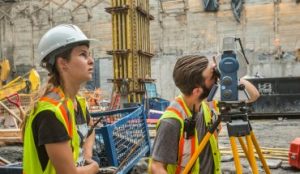Innovation and smart technology is fast becoming a staple in construction.
It is estimated that the GDP for the construction industry in Canada in 2018 stood at around 141.6 billion Canadian dollars, and similarly strong 2019 figures are trending and will soon be reported by Stats Canada. The complexity of new projects in the country has also escalated the use of technological innovations such as Building Information Modeling (BIM), pre-fabrication, and modularization.

Ramzi Jredini, CEO Handiss
Ramzi Jredini, CEO of construction hiring platform Handiss, believes the implementation of digitized construction will grow significantly in Canada, and provide environmental benefits as well as a significant return on investment for owners.
What is digitized construction?
“Digitized construction is a broad term that includes all kinds of technological advancement on and off the construction site,” began Jredini. “Everything in construction technology can fall under that term, whether we’re talking about new apps for the construction site, drones, sensor technologies, BIM, VR, and even robot labour replacing skilled labour.”
Jredini explained, “Digitizing and innovating in construction happens either to solve problems that exist in the industry or to improve inefficient processes. The results are improved efficiency for a notoriously inefficient industry.”
Jredini added, “What we are doing at Handiss is introducing better talent management through a digital hiring solution tailored for the industry, and that falls under that category, too.” Handiss is a digital talent management platform tailored for the construction industry.
“Our clients are contractors and consultants in the industry,” shared Jredini. “Companies in Canada, the US, Europe, and the Middle East have hired freelancers for remote work through Handiss…. We’ve just started rolling out our full-time and contract hiring solution only in Toronto, where our clients have access to a searchable and industry specific database of engineers and architects in addition to human recruiting support.”
I asked Jredini how the gig economy plays a role in construction in Canada, to which he replied, “The gig economy, or to put it in more common terminology, temporary work, has been at the core of the construction industry long before the gig economy turned digital (in part).”

Ryerson University’s Church Street Development photos by ©2016, Norm Betts, photographer
“Construction workers move from one project to another, and so do engineers and architects who design and manage these projects,” Jredini said. “It all just happens through networking and personal connections in the most part, and any person who works in this industry will tell you the same. What we are doing at Handiss is just taking this experience online and making it easier to track down people with the needed skills, especially that there are ever increasing niches and specialties in this complex industry and it’s becoming harder to track many of these skills down.”
I asked Jredini to describe the future he envisions for the construction industry in Canada.
“Canada and the US are both pushing the boundaries in construction tech by adopting new technologies and trying them out,” remarked Jredini. “They’re definitely leading the world in this area, with contractors introducing drones, sensors, apps, and new software to their construction sites and operations, and that opens doors for startups and new ideas.”
“With planned investments by the government in infrastructure across different sectors, and a solid growth in the market, Canada’s construction industry is projected to reach $304.6B by 2023, and this growth means progress and room for more innovation in the industry,” said Jredini.
“I’m excited to see some of these new ideas and concepts we see popping up everyday become realities.”
Related: Gig Economy



